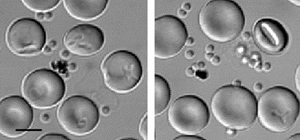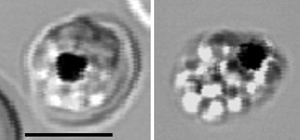
The deadliest malaria parasite needs two proteins to infect red blood cells and exit the cells after it multiplies, a finding that may provide researchers with potential new targets for drug development, according to researchers funded by the National Institutes of Health. Their study appears in the latest issue of Science.
Plasmodium falciparum, the species of parasite that causes the most malaria deaths worldwide, has developed drug-resistance in five countries in Southeast Asia.
In the current study, researchers sought to uncover the role of plasmepsins IX and X, two of the 10 types of plasmepsin proteins produced by P. falciparum for metabolic and other processes. They created malaria parasites that lacked plasmepsin IX or X under experimental conditions and compared them to those that had the two proteins.

The team found plasmepsin IX in rhoptries, specialized cell structures inside the parasite, which help it invade red blood cells. Parasites lacking plasmepsin IX had defective rhoptries. In addition, the team observed plasmepsin X in exonemes—small vesicles (balloon-like structures) that help malaria parasites exit infected cells. The team also discovered that plasmepsin X processes an important protein called SUB1. When deprived of plasmepsin X, the parasites couldn't process SUB1 and couldn't infect red blood cells or exit these cells after multiplying.
The researchers also identified three experimental malaria drugs that may work by targeting plasmepsin X. One drug, called CWHM-117, has already been tested in a mouse model of malaria. The new findings may help researchers modify CWHM-117 to make it more effective. Furthermore, parasites lacking the plasmepsins could potentially be used to screen candidate drugs to identify additional anti-malaria compounds.
The study was conducted in part by researchers from NIH's Eunice Kennedy Shriver National Institute of Child Health and Human Development (NICHD) and the Washington University School of Medicine in Saint Louis. Funding also was provided by the National Institute of Allergy and Infectious Diseases, the National Heart, Lung, and Blood Institute, and the National Institute of General Medical Sciences.
ARTICLE:
Nasamu AS, Glushakova S, Russo I, Vaupel B, Oksman A, Kim AS, Fremont DH, Tolia N, Beck JR, Meyers MJ, Niles JC, Zimmerberg J, and Goldberg DE. Plasmepsins IX and X are essential and druggable mediators of malaria parasite egress and invasion. Science DOI: 10.1126/science.aan1478 (2017)
###
About the Eunice Kennedy Shriver National Institute of Child Health and Human Development (NICHD): NICHD conducts and supports research in the United States and throughout the world on fetal, infant and child development; maternal, child and family health; reproductive biology and population issues; and medical rehabilitation. For more information, visit NICHD's website.
About the National Institutes of Health (NIH): NIH, the nation's medical research agency, includes 27 Institutes and Centers and is a component of the U.S. Department of Health and Human Services. NIH is the primary federal agency conducting and supporting basic, clinical, and translational medical research, and is investigating the causes, treatments, and cures for both common and rare diseases. For more information about NIH and its programs, visit http://www.nih.gov.

 BACK TO TOP
BACK TO TOP